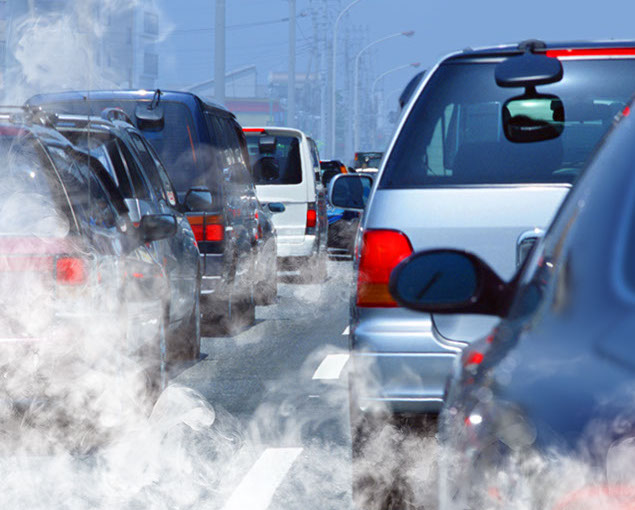Worth Its
Weight In Steel
Around the world, carmakers are under pressure to reduce emissions from their vehicles. A new lightweight steel developed at HKU could make a difference by substantially reducing fuel consumption and thus emissions.


Tiny Hong Kong is an unexpected place to find research into automotive steel. There are no steelmakers here to test the product, nor big car manufacturers to fund research. But Dr Huang Mingxin of the Department of Mechanical Engineering, working within those limits, has managed to develop a new type of car steel that offers significant environmental benefits while remaining strong, flexible and, most importantly, affordable. He has also lined up industrial players to take his discovery forward.
The green benefits come from addressing one of the key concerns in the auto industry, which is how to reduce fuel consumption and thereby emissions. Governments around the world are tightening their fuel efficiency standards – in China, for instance it must reach five litres per 100 kilometres by 2020 and in the US 54.5 miles per gallon by 2025.
One of the most straightforward solutions is to reduce the weight of vehicles so they consume less fuel.
“You can do that by using new materials like carbon fibres, which are very light but then you have to look at the cost,” Dr Huang said. “We’re talking about family cars, affordable cars, not sports cars. Therefore, we have to look at reducing the weight of materials already being used. Steel is the obvious first choice.”
Dr Huang has been researching steel for many years, starting in France where he worked in the research and develeopment centre of ArcelorMittal, the world’s largest steel maker, before joining HKU in 2010. His work there focussed on making car steel lighter while retaining its ‘ductility’ – its ability to be bent or shaped.
That work led to his recent development of ultra-lightweight automobile steel, which is not only light and ductile but as strong as conventional steel – an essential condition for safety.
%20could%20be%20made%20of%20the%20nanotwinned%20steel.jpg)
Parts (in red) could be made of the nanotwinned steel.

![]() This steel could reduce car weight by 30 per cent and if you do that you will typically have 20 per cent less fuel consumption, which would mean 20 per cent fewer emissions.
This steel could reduce car weight by 30 per cent and if you do that you will typically have 20 per cent less fuel consumption, which would mean 20 per cent fewer emissions.![]()
Dr Huang Mingxin
Strong but not brittle
“There is always this contradiction in steel-making between strength and brittleness. Although you can make thinner steel with high strength that meets safety standards, in general if you increase strength the material becomes very brittle. And when that happens how can you shape the steel into components?”
He has answered this problem by using nanotechnology to manipulate the crystal structure of the steel so that nano-sized ‘twins’ are created when the crystal is sheared in a certain way. This produces a mirror image between which there are boundaries that act to limit the movement of defects in the crystals, thus increasing their strength. The nanotwins also have the effect of increasing ductility, so the steel is made both stronger and more flexible while only half as thick as the steel currently used in automobiles.
“Carmakers don’t need such material as yet because the tighter energy standards won’t be in place for a few years. But we would like to convince them that they don’t need to wait,” Dr Huang said.
He is working with Ansteel, China’s second largest steelmaker, and General Motors on ways to do large-scale testing of the material. “I think of it as a golden triangle – there is the materials producer Ansteel, the materials user General Motors, and the third side which proposes ideas which is academics,” he said.
%20is%20only%20half%20as%20thick%20(100mm)%20as%20the%20steel%20now%20used%20in%20automobiles%20(left%2c%20202mm)%2c%20while%20offering%20the%20same%20strength%20and%20ductility-crop-u9049.jpg)
The new generation of automobile steel (right) is only half as thick (1.00mm) as the steel now used in automobiles (left, 2.02mm), while offering the same strength and ductility.
The ‘trick’ is in the cost
A key advantage of the nanotwin technology is that it does not need special manufacturing facilities – it can be made in existing plants. Moreover, the overall cost is about the same as the best conventional steel used today.
“That is our trick. Although the unit cost of the material may be a little more expensive, because you use less material the total cost will be very similar to components made of existing steels,” he said.
Cars are not the only possible use of this steel. Given its strength and flexibility, it could be applied in anything from bridges and airplane landing gear to military tank protection and police helmets.
For now, though, Dr Huang is focussed on seeing the steel tested properly for vehicles to confirm that it will offer the same crash performance and passenger protection as conventional steel. And betting that the steel will be a green solution for carmakers.
“This steel could reduce car weight by 30 per cent and if you do that you will typically have 20 per cent less fuel consumption, which would mean 20 per cent fewer emissions,” he said.
By keeping the barriers low to bringing the product to market, the hope is that that impact will be achieved sooner rather than later.

